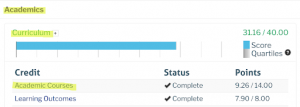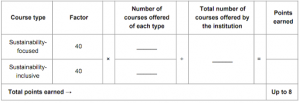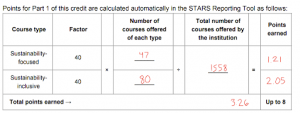Interpreting STARS: What Our Rating Means and How It Was Calculated
Author: Oliver Jones
Institutions of higher education take on many roles in relation to sustainability. Colleges consume resources, produce waste, research impacts, and encourage values in their students as environmental citizens.
Consideration of these several roles has led reporting & rating programs, such as the Association for the Advancement in Higher Education’s (AASHE) Sustainability Tracking and Rating System (STARS), to be increasingly complex. As a result, the STARS system can be difficult to parse at first glance. You may know CofC has a Silver STARS rating, but what does that actually mean? Let’s break it down.
Categorizing The Data
If a college or university decides to participate in the STARS program, they need to gather a range of information. This includes data on sustainability initiatives (like curriculum & community engagement) as well as performance (like facility operations).
Data is divided into four required categories:
- Academics
- Engagement
- Operations
- Planning & Administration
And an optional ‘bonus’ category:
- Innovation & Leadership
These main categories sometimes contain subcategories. For example, the first listed category is ‘Academics,’ which has two subcategories: ‘Curriculum’ and ‘Research.’ These categories or subcategories are made up of groups of credits, which are the base units of measurement.
CofC example:
The first category listed is ‘Academics,’ which has two subcategories, the first of which is ‘Curriculum.’ Under this, the first credit is ‘Academic Courses.’
Scoring The Categories
Once an institution collects all of the required data and enters it into the STARS online portal, it typically goes through a back-and-forth of review and revision between the submitting institution & AASHE. After any issues identified by the review process have been corrected, the data is ready to be scored.
Each credit has a variable amount of maximum points available. Credits also have individualized rules outlined in the Technical Manual, including expected timeframe, sampling & data standards, and minimum requirements to qualify.
Credits that don’t apply to an institution (outlined in the “Applicability” section of a credit description) don’t count against their score total.
CofC example:
For our credit example of ‘Academic Courses,’ there are two parts to score calculation. Part 1 measures the percentage of courses offered that involve sustainability in some way. The table is as follows:
If we plug in CofC’s information – provided in the 2020 report – we see that our Part 1 score totals to 3.26 points.
Part 2 measures the percentage of departments on campus that offer sustainability-related courses. The table used for calculation is seen below:
Once CofC’s information is entered, we can see that CofC scored full marks (6 points) for Part 2 of this credit!
Adding these two parts results in a total score of 9.26, which we can see reflected in the final score report below.
The Final Score
After all applicable credits have been scored, all earned points can be summed. The final score is based on the percentage of available points earned in addition to a maximum of 4 ‘Innovation & Leadership’ bonus points. This means the total possible final score for an institution is 104.
CofC earned the total 4 bonus points awarded for innovation, and as a result, had a total of 55.42 final points.
So, Where Do We Go From Here?
Out of the 348 institutions with an unexpired STARS rating, Silver ratings are the most common, with 150 institutions scoring the minimum 45 points. However, Gold institutions are not far behind, with 129 institutions scoring at least 65 to qualify.
Now, strengthened with the knowledge that the College can achieve success in this sustainability benchmark, we can continue to improve. As we enter our last year of the QEP, interdisciplinary cooperation, collective involvement, and continued discussion will be imperative as we strive towards Gold.
More about the general STARS program
‘The College Today’ news brief | CofC Earns Silver Rating
More on-campus sustainability initiatives









